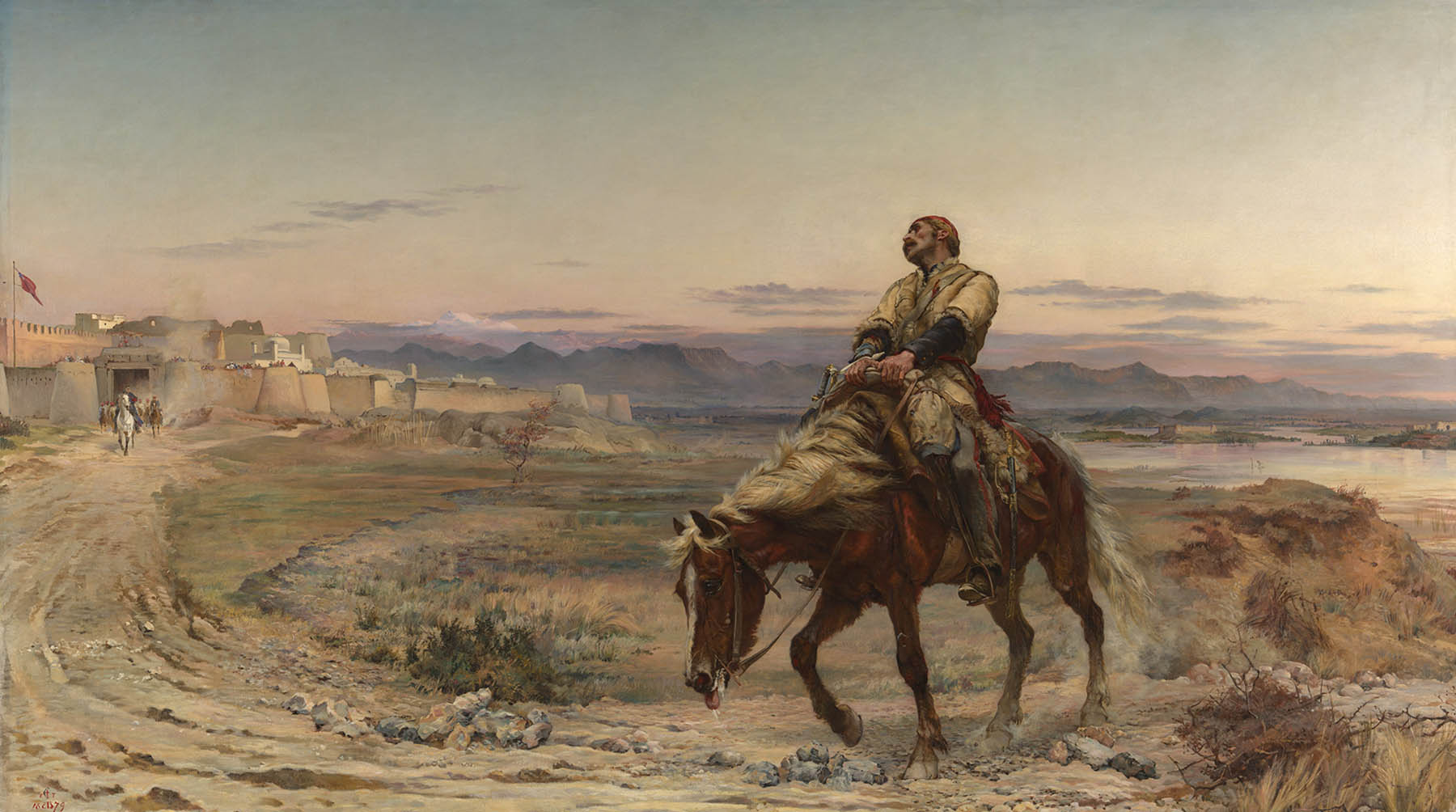My Favourite Painting: Levison Wood
The explorer Levison Wood chooses a dramatic portrait of war dating back 150 years.


Levison Wood on his choice of 'Remnants of an Army' by Elizabeth Thompson, Lady Butler
‘Afghanistan has long held a dear place in my heart. I first visited in 2004 as a young backpacker and have returned many times since, both in my career in the army and as a journalist.
'This painting depicts Dr William Brydon, initially thought to be the only army survivor of the 1842 retreat from Kabul in the First Anglo-Afghan War. My new book, about the Taliban takeover of Afghanistan in 2021 and the allied evacuation mission, seems eerily reminiscent.
'The despair in Thompson’s image is a stark reminder of the futility of war and its huge human cost — a most poignant message given current world affairs.’
Levison Wood is an explorer, author and photographer. His most recent book, Escape from Kabul, is out now.
Charlotte Mullins on Remnants of an Army
Elizabeth Thompson, later Lady Butler after her husband, army officer William Butler, was knighted, trained as an artist in Florence, Rome and London. She was inspired to paint military subjects following a family trip to Paris shortly after the Franco-Prussian war of 1870–71. She observed that in France there was a buoyant market for military paintings, but, in Britain, it was a rather neglected art form. With this in mind, she painted scenes from historic wars, including the Crimean and the Battle of Waterloo, giving her protagonists heroic courage in the face of adversity.
This painting is based on the First Anglo-Afghan war of 1838–42. Imperial Britain wished to protect India from invasion by Russian forces by ensuring that Afghanistan — the country abutting India’s western border—favoured Britain. War ensued and, although the British-Indian army took Kabul in 1839, it was forced to retreat in January 1842. Unprotected as it made its way through eastern Afghanistan, most of the 4,500 troops were killed.
Only one European survivor, Dr William Brydon, was said to have made it back to the British-held fort at Jalalabad. Lady Butler paints him on horseback, exhausted and frozen by the cloudless winter night. Dawn breaks as men ride to meet him from the fort and his horse picks its way wearily over stony ground.
In 1879, the year this painting was completed, Lady Butler was denied a place as an associate of the Royal Academy as a woman, despite creating a new market for military art in Britain, commanding high prices for the publishing rights to her paintings and receiving royal patronage.
Sign up for the Country Life Newsletter
Exquisite houses, the beauty of Nature, and how to get the most from your life, straight to your inbox.

Charlotte Mullins is an art critic, writer and broadcaster. Her latest book, The Art Isles: A 15,000 year story of art in the British Isles, will be published by Yale University Press in October 2025.
-
 The King's favourite tea, conclave and spring flowers: Country Life Quiz of the Day, April 22, 2025
The King's favourite tea, conclave and spring flowers: Country Life Quiz of the Day, April 22, 2025Tuesday's Quiz of the Day blows smoke, tells the time and more.
By Toby Keel
-
 London is the place for me* (*the discerning property buyer)
London is the place for me* (*the discerning property buyer)With more buyers looking at London than anywhere else, is the 'race for space' finally over?
By Annabel Dixon
-
 'As a child I wanted to snuggle up with the dogs and be part of it': Alexia Robinson chooses her favourite painting
'As a child I wanted to snuggle up with the dogs and be part of it': Alexia Robinson chooses her favourite paintingAlexia Robinson, founder of Love British Food, chooses an Edwin Landseer classic.
By Charlotte Mullins
-
 The Pre-Raphaelite painter who swapped 'willowy, nubile women' for stained glass — and created some of the best examples in Britain
The Pre-Raphaelite painter who swapped 'willowy, nubile women' for stained glass — and created some of the best examples in BritainThe painter Edward Burne-Jones turned from paint to glass for much of his career. James Hughes, director of the Victorian Society, chooses a glass masterpiece by Burne-Jones as his favourite 'painting'.
By Charlotte Mullins
-
 'I can’t look away. I’m captivated': The painter who takes years over each portrait, with the only guarantee being that it won't look like the subject
'I can’t look away. I’m captivated': The painter who takes years over each portrait, with the only guarantee being that it won't look like the subjectFor Country Life's My Favourite Painting slot, the writer Emily Howes chooses a work by a daring and challenging artist: Frank Auerbach.
By Toby Keel
-
 My Favourite Painting: Rob Houchen
My Favourite Painting: Rob HouchenThe actor Rob Houchen chooses a bold and challenging Egon Schiele work.
By Charlotte Mullins
-
 My Favourite Painting: Jeremy Clarkson
My Favourite Painting: Jeremy Clarkson'That's why this is my favourite painting. Because it invites you to imagine'
By Charlotte Mullins
-
 The chair of the National Gallery names his favourite from among the 2,300 masterpieces — and it will come as a bit of a shock
The chair of the National Gallery names his favourite from among the 2,300 masterpieces — and it will come as a bit of a shockAs the National Gallery turns 200, the chair of its board of trustees, John Booth, chooses his favourite painting.
By Toby Keel
-
 'A wonderful reminder of what the countryside could and should be': The 200-year-old watercolour of a world fast disappearing
'A wonderful reminder of what the countryside could and should be': The 200-year-old watercolour of a world fast disappearingChristopher Price of the Rare Breed Survival Trust on the bucolic beauty of The Magic Apple Tree by Samuel Palmer, which he nominates as his favourite painting.
By Charlotte Mullins
-
 My favourite painting: Andrew Graham-Dixon
My favourite painting: Andrew Graham-Dixon'Lesson Number One: it’s the pictures that baffle and tantalise you that stay in the mind forever .'
By Country Life